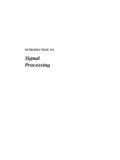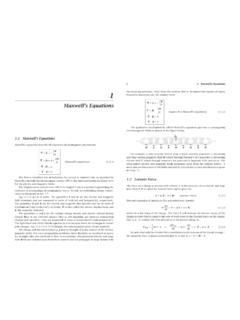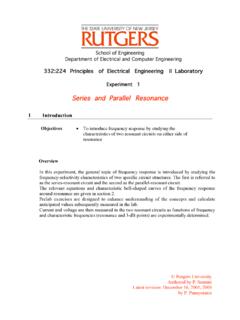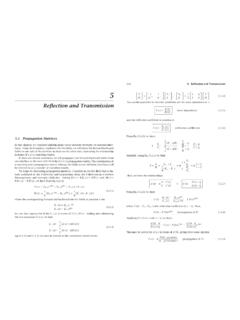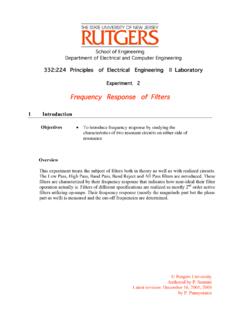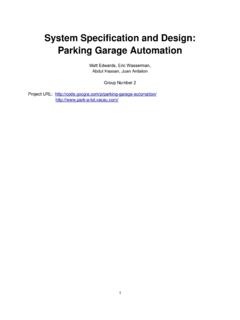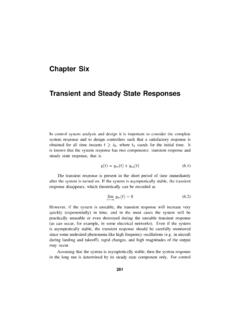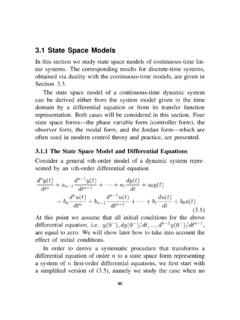Transcription of Maxwell’s Equations - Rutgers University
1 2 1. Maxwell's Equations the receiving antennas. Away from the sources, that is, in source-free regions of space, 1 Maxwell's Equations take the simpler form: B. E= . Maxwell's Equations D. t H=. t (source-free Maxwell's Equations ) ( ). D=0. B=0. The qualitative mechanism by which Maxwell's Equations give rise to propagating electromagnetic elds is shown in the gure below. Maxwell's Equations Maxwell's Equations describe all (classical) electromagnetic phenomena: B. E= For example, a time-varying current J on a linear antenna generates a circulating t and time-varying magnetic eld H, which through Faraday's law generates a circulating D.
2 H=J+ electric eld E, which through Ampe re's law generates a magnetic eld, and so on. The t (Maxwell's Equations ) ( ). cross-linked electric and magnetic elds propagate away from the current source. A. D= more precise discussion of the elds radiated by a localized current distribution is given in Chap. 15. B=0. The rst is Faraday's law of induction, the second is Ampe re's law as amended by Maxwell to include the displacement current D/ t, the third and fourth are Gauss' laws Lorentz force for the electric and magnetic elds. The force on a charge q moving with velocity v in the presence of an electric and mag- The displacement current term D/ t in Ampe re's law is essential in predicting the netic eld E, B is called the Lorentz force and is given by: existence of propagating electromagnetic waves.
3 Its role in establishing charge conser- vation is discussed in Sec. F = q(E + v B) (Lorentz force ) ( ). Eqs. ( ) are in SI units. The quantities E and H are the electric and magnetic eld intensities and are measured in units of [volt/m] and [ampere/m], respectively. newton 's equation of motion is (for non-relativistic speeds): The quantities D and B are the electric and magnetic ux densities and are in units of [coulomb/m2 ] and [weber/m2 ], or [tesla]. D is also called the electric displacement, and dv m = F = q(E + v B) ( ). B, the magnetic induction. dt The quantities and J are the volume charge density and electric current density where m is the mass of the charge.
4 The force F will increase the kinetic energy of the (charge ux) of any external charges (that is, not including any induced polarization charge at a rate that is equal to the rate of work done by the Lorentz force on the charge, charges and currents.) They are measured in units of [coulomb/m3 ] and [ampere/m2 ]. that is, v F. Indeed, the time-derivative of the kinetic energy is: The right-hand side of the fourth equation is zero because there are no magnetic mono- 1 dWkin dv pole charges. Eqs. ( ) ( ) display the induced polarization terms explicitly. Wkin = mv v = mv = v F = qv E ( ). The charge and current densities , J may be thought of as the sources of the electro- 2 dt dt magnetic elds.
5 For wave propagation problems, these densities are localized in space; We note that only the electric force contributes to the increase of the kinetic energy . for example, they are restricted to ow on an antenna. The generated electric and mag- the magnetic force remains perpendicular to v, that is, v (v B)= 0. netic elds are radiated away from these sources and can propagate to large distances to Constitutive Relations 3 4 1. Maxwell's Equations Volume charge and current distributions , J are also subjected to forces in the The next simplest form of the constitutive relations is for simple homogeneous presence of elds.
6 The Lorentz force per unit volume acting on , J is given by: isotropic dielectric and for magnetic materials: f = E + J B (Lorentz force per unit volume) ( ) D = E. ( ). 3. where f is measured in units of [ newton /m ]. If J arises from the motion of charges B = H. within the distribution , then J = v (as explained in Sec. ) In this case, These are typically valid at low frequencies. The permittivity and permeability . f = (E + v B) ( ) are related to the electric and magnetic susceptibilities of the material as follows: By analogy with Eq. ( ), the quantity v f = v E = J E represents the power = 0 (1 + ).
7 Per unit volume of the forces acting on the moving charges, that is, the power expended ( ). by (or lost from) the elds and converted into kinetic energy of the charges, or heat. It = 0 (1 + m ). has units of [watts/m3 ]. We will denote it by: The susceptibilities , m are measures of the electric and magnetic polarization dPloss properties of the material. For example, we have for the electric ux density: =J E (ohmic power losses per unit volume) ( ). dV. D = E = 0 (1 + )E = 0 E + 0 E = 0 E + P ( ). In Sec. , we discuss its role in the conservation of energy. We will nd that elec- tromagnetic energy owing into a region will partially increase the stored energy in that where the quantity P = 0 E represents the dielectric polarization of the material, that region and partially dissipate into heat according to Eq.
8 ( ). is, the average electric dipole moment per unit volume. In a magnetic material, we have B = 0 (H + M)= 0 (H + m H)= 0 (1 + m )H = H ( ). Constitutive Relations where M = m H is the magnetization, that is, the average magnetic moment per unit The electric and magnetic ux densities D, B are related to the eld intensities E, H via volume. The speed of light in the material and the characteristic impedance are: the so-called constitutive relations, whose precise form depends on the material in which . 1 . the elds exist. In vacuum, they take their simplest form: c= , = ( ).. D = 0 E The relative permittivity, permeability and refractive index of a material are de ned by: ( ).
9 B = 0 H . rel = = 1 + , rel = = 1 + m , n= rel rel ( ). 0 0. where 0 , 0 are the permittivity and permeability of vacuum, with numerical values: so that n2 = rel rel . Using the de nition of Eq. ( ), we may relate the speed of light and impedance of the material to the corresponding vacuum values: 0 = 10 12 farad/m ( ) 1 1 c0 c0. 0 = 4 10 7 henry/m c= = = =. 0 0 rel rel rel rel n ( ). The units for 0 and 0 are the units of the ratios D/E and B/H, that is, 0 rel rel rel n = = = 0 = 0 = 0. 0 rel rel n rel coulomb/m2 coulomb farad weber/m2 weber henry = = , = =. volt/m volt m m ampere/m ampere m m For a non-magnetic material, we have = 0 , or, rel = 1, and the impedance becomes simply = 0 /n, a relationship that we will use extensively in this book.
10 From the two quantities 0 , 0 , we can de ne two other physical constants, namely, More generally, constitutive relations may be inhomogeneous, anisotropic, nonlin- the speed of light and the characteristic impedance of vacuum: ear, frequency dependent (dispersive), or all of the above. In inhomogeneous materials, the permittivity depends on the location within the material: 1 0. c0 = = 3 108 m/sec , 0 = = 377 ohm ( ). 0 0 0 D(r, t)= (r)E(r, t). Constitutive Relations 5 6 1. Maxwell's Equations In anisotropic materials, depends on the x, y, z direction and the constitutive rela- In Sections , we discuss simple models of ( ) for dielectrics, conductors, tions may be written component-wise in matrix (or tensor) form: and plasmas, and clarify the nature of Ohm's law.
